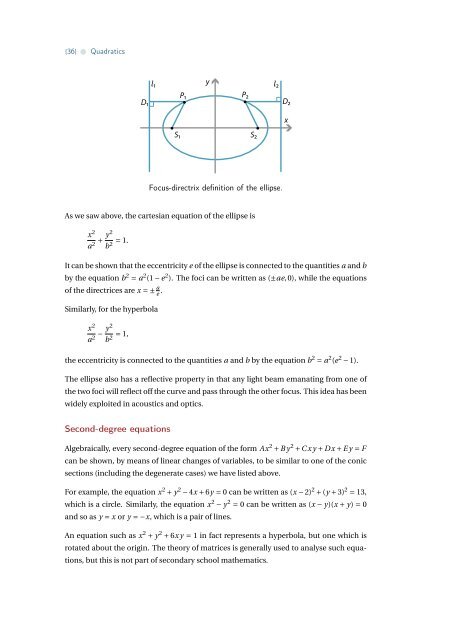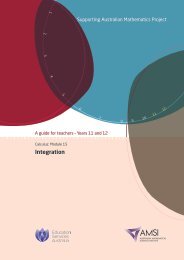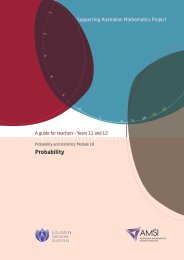Quadratics - the Australian Mathematical Sciences Institute
Quadratics - the Australian Mathematical Sciences Institute
Quadratics - the Australian Mathematical Sciences Institute
You also want an ePaper? Increase the reach of your titles
YUMPU automatically turns print PDFs into web optimized ePapers that Google loves.
{36} • <strong>Quadratics</strong><br />
D1<br />
l1<br />
P1<br />
y<br />
P2<br />
l2<br />
D2<br />
S1<br />
S2<br />
x<br />
Focus-directrix definition of <strong>the</strong> ellipse.<br />
As we saw above, <strong>the</strong> cartesian equation of <strong>the</strong> ellipse is<br />
x 2<br />
a 2 + y 2<br />
b 2 = 1.<br />
It can be shown that <strong>the</strong> eccentricity e of <strong>the</strong> ellipse is connected to <strong>the</strong> quantities a and b<br />
by <strong>the</strong> equation b 2 = a 2 (1 − e 2 ). The foci can be written as (±ae,0), while <strong>the</strong> equations<br />
of <strong>the</strong> directrices are x = ± a e .<br />
Similarly, for <strong>the</strong> hyperbola<br />
x 2<br />
a 2 − y 2<br />
b 2 = 1,<br />
<strong>the</strong> eccentricity is connected to <strong>the</strong> quantities a and b by <strong>the</strong> equation b 2 = a 2 (e 2 − 1).<br />
The ellipse also has a reflective property in that any light beam emanating from one of<br />
<strong>the</strong> two foci will reflect off <strong>the</strong> curve and pass through <strong>the</strong> o<strong>the</strong>r focus. This idea has been<br />
widely exploited in acoustics and optics.<br />
Second-degree equations<br />
Algebraically, every second-degree equation of <strong>the</strong> form Ax 2 + B y 2 +C x y + Dx + E y = F<br />
can be shown, by means of linear changes of variables, to be similar to one of <strong>the</strong> conic<br />
sections (including <strong>the</strong> degenerate cases) we have listed above.<br />
For example, <strong>the</strong> equation x 2 + y 2 − 4x + 6y = 0 can be written as (x − 2) 2 + (y + 3) 2 = 13,<br />
which is a circle. Similarly, <strong>the</strong> equation x 2 − y 2 = 0 can be written as (x − y)(x + y) = 0<br />
and so as y = x or y = −x, which is a pair of lines.<br />
An equation such as x 2 + y 2 + 6x y = 1 in fact represents a hyperbola, but one which is<br />
rotated about <strong>the</strong> origin. The <strong>the</strong>ory of matrices is generally used to analyse such equations,<br />
but this is not part of secondary school ma<strong>the</strong>matics.
















